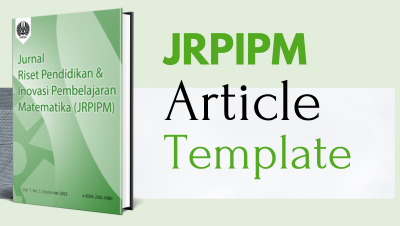The Implementation of Microsite-Assisted Gamification to Improve Students’ Memory Retention in Mathematics Learning
DOI:
https://doi.org/10.26740/jrpipm.v9n1.p46-57Keywords:
Gamification, Microsite, Memory Retention, Mathematics LearningAbstract
This study was motivated by the urgency of utilizing technological advancements in education to optimize students' memory retention in mathematics learning, which is known to require deep and continuous conceptual understanding. The objective of this research is to investigate the improvement of students' memory retention after the implementation of gamification supported by a microsite in mathematics learning. The research employed a quantitative approach with a population consisting of all 10th-grade students at SMA Negeri 1 Sumber in the 2024/2025 academic year, totaling 439 students. The sample was selected using cluster random sampling, specifically class X-7 consisting of 35 students. Data collection techniques included a memory retention test and unstructured interviews. The data were analyzed using the N-Gain formula and a paired sample t-test. The results of the study showed an improvement in students' memory retention in the class that implemented gamification supported by a microsite, with the improvement categorized as high. Based on the hypothesis testing, students' memory retention after the implementation of gamification supported by a microsite was significantly better compared to before the implementation. Therefore, gamification supported by a microsite has been proven effective in enhancing students' memory retention in mathematics learning.
References
Adilah, G. P., Utaya, S., & Suharto, Y. (2025). Pengaruh Model Resource Based Learning Berbantuan Microsite Terhadap Hasil Belajar Ditinjau dari Motivasi Belajar Siswa. Cetta: Jurnal Ilmu Pendidikan, 8(1), 195–210. https://doi.org/10.37329/cetta.v8i1.3859
Aiken, L. R. (1985). Three Coefficients for Analyzing the Reliability and Validity of Ratings. Educational and Psychological Measurement, 45(1), 131–142. https://doi.org/10.1177/0013164485451012
Alam, R. A. N., Elvandari, T. H., & Wahid, A. (2024). Desain LinEq-TV Maze untuk Memfasilitasi Retensi dan Minat Belajar Peserta Didik. Uninus Journal of Mathematics Education and Science (UJMES)., 9(2), 121–127. https://doi.org/10.30999/ujmes.v9i2.3198
Ekawati, R., Wasis, W., Shodikin, A., Fiangga, S., & Jian-Cheng, C. (2024). Utilizing Games to Enhance the Learning of Students with Dyslexia: A Systematic Literature Review. TEM Journal, 13(3), 2097-2106. http://doi.org/10.18421/TEM133-37
Haqq, A. A., Handoko, H., & Syafianti, A. (2024). Implementation of H5P-assisted Teaching Materials on Mathematical Understanding Based on Learning Style. EduMa : Mathematics Education Learning and Teaching, 13(2), 196–208. https://doi.org/10.24235/eduma.v13i2
Helsa, Ariani, Andika, Zainil, Masniladevi, & Ranuharja. (2022). Ketergantungan pada Teknologi: Intelectual Virtual Photo Math Solves Equations with Mobile Camera. Journal on Mathematics Education Research, 3(2), 91–98. https://doi.org/10.17509/j-mer.v3i2.49397
Hilgard, E. R., & Bower, G. H. (1975). Theories of Learning (4th ed.). Prentice Hall.
Juwairiah, Sembiring, D., Kadirun, & Rukhmana, T. (2024). Penyuluh Pelatihan Membuat Media Pembelajaran Animasi Flash Kepada Guru-Guru Sekolah Dasar di Kecamatan Nirwana. Journal of Human and Education (JAHE), 4(4), 729–736. https://doi.org/10.31004/jh.v4i4.1334
Khasawneh, Y. J. A., Khasawneh, N., & Khasawneh, M. A. S. (2024). Exploring the Long-Term Effects: Retention and Transfer of Skills in Gamified Learning Environment. International Journal of Data and Network Science, 8(1), 195–200. https://doi.org/10.5267/j.ijdns.2023.10.004
Lutfi, A., Aftinia, F., & Permani, B. E. (2023). Gamification: Game As a Medium for Learning Chemistry to Motivate and Increase Retention of Students’ Learning Outcomes. Journal of Technology and Science Education, 13(1), 193–207. https://doi.org/10.3926/jotse.1842
Mahmubi, M., & Homaidi. (2025). Analisis Implementasi Pembelajaran Berbasis Gamifikasi Pada Peningkatan Motivasi Belajar Siswa. Jurnal Al-Abshor: Jurnal Pendidikan Agama Islam, 2(1), 286–294. https://doi.org/10.71242/wf9q5253
Mattawang, M. R., & Syarif, E. (2023). Dampak Penggunaan Kahoot Sebagai Platform Gamifikasi dalam Proses Pembelajaran. Journal of Learning and Technology, 2(1), 33–42. https://doi.org/10.33830/jlt.v2i1.5843
Mirzaie, B. F. A., Samani, N. K., Akhlaghi, A., Najibi, S., & Bolourian, M. (2022). Pros and Cons of Tomorrow’s Learning: A Review of Literature of Gamification in Education Context. Medical Education Bulletin, 3(4), 543–554. https://doi.org/10.22034/meb.2022.350941.1063
Mursalin, Fonna, M., Elisyah, N., Ali, M., & Armita, D. (2024). Pelatihan Penerapan Gamifikasi dalam Pembelajaran Matematika untuk Mahasiswa Calon Guru SMK. Jurnal Solusi Masyarakat Dikara, 4(1), 30–37. https://doi.org/10.5281/zenodo.12344885
Nurfalah, E., & Rahayu, P. (2023). Microsite-Based Mathematical Statistics Educational Media to Increase Student Study Motivation After the Covid-19 Pandemic. Jurnal Riset Pendidikan dan Inovasi Pembelajaran Matematika (JRPIPM), 7(1), 67–74. https://doi.org/10.26740/jrpipm.v7n1.p67-74
Nurjannah, Kaswar, A. B., & Kasim, E. W. (2021). Efektifitas Gamifikasi Dalam Pembelajaran Matematika. Jurnal MathEdu (Mathematic Education Journal), 4(2), 189–193. https://doi.org/10.37081/mathedu.v4i2.2492
Safitri, E., Purwitaningtyas, R. Y., & Nuzula, F. (2023). Pengaruh Warna terhadap Short Term Memory pada Remaja. Jurnal Ilmiah Kesehatan Rustida, 10(1), 29–36. https://doi.org/10.55500/jikr.v10i1.180
Sanulita, H., Syamsurijal, S., Ardiansyah, W., Wiliyanti, V., & Megawati, R. (2024). Strategi Pembelajaran: Teori & Metode Pembelajaran Efektif (1 st ed.). PT. Sonpedia Publishing Indonesia.
Setyaningsih, E. (2023). Perkembangan Multimedia Digital dan Pembelajaran. Indonesian Journal of Learning and Instructional Innovation, 1(1), 24–34. https://doi.org/10.20961/ijolii.v1i01.920
Siregar, F. R., & Mawardi. (2022). Development of the Learning System of Flipped-Guided Inquiry-Based Learning (FGIL) Using Moodle on Chemical Equilibrium Material. Indonesian Journal of Educational Studies, 25(1), 31–49. https://doi.org/10.26858/ijes.v25i1.33568
Srimuliyani. (2023). Menggunakan Teknik Gamifikasi untuk Meningatkan Pembelajaran dan Keterlibatan Siswa di Kelas. Educare: Jurnal Pendidikan Dan Kesehatan, 1(1), 29–35. https://doi.org/10.37985/jedu.v1i1.2
Sukarelawan, M. I., Indratno, T. K., & Ayu, S. M. (2024). N-Gain vs Stacking (1st ed.). Suryacahaya.
Sweller, J. (1988). Cognitive Load During Problem Solving: Effects on Learning. Cognitive Science, 12(2), 257–285. https://doi.org/10.1016/0364-0213(88)90023-7
Triswidrananta, O. D., Pramudhita, A. N., Wahono, W. T., & Wijaya, E. M. S. (2024). Development of E-Learning Gamification to Improve Mathematics Learning Results. Inteligensi: Jurnal Ilmu Pendidikan, 7(2), 119–126. https://doi.org/10.33366/ilg.v7i2.6534
Valderama, J., & Oligo, J. (2021). Learning Retention in Mathematics Over Consecutive Weeks: Impact of Motivated Forgetting. International Journal of Evaluation and Research in Education, 10(4), 1245–1254. https://doi.org/10.11591/IJERE.V10I4.21577
Wangi, N. B. S., Chandra, N. E., Ali, A. Z., Aulia, L. L., Zahid, A., Triutami, M. W., & Biroudloh, F. (2022). Pembelajaran Daring Berbasis Gamifikasi (1st ed.). Delsmedia.
Downloads
Published
How to Cite
Issue
Section
 Abstract views: 80
,
Abstract views: 80
, PDF Downloads: 73
PDF Downloads: 73






